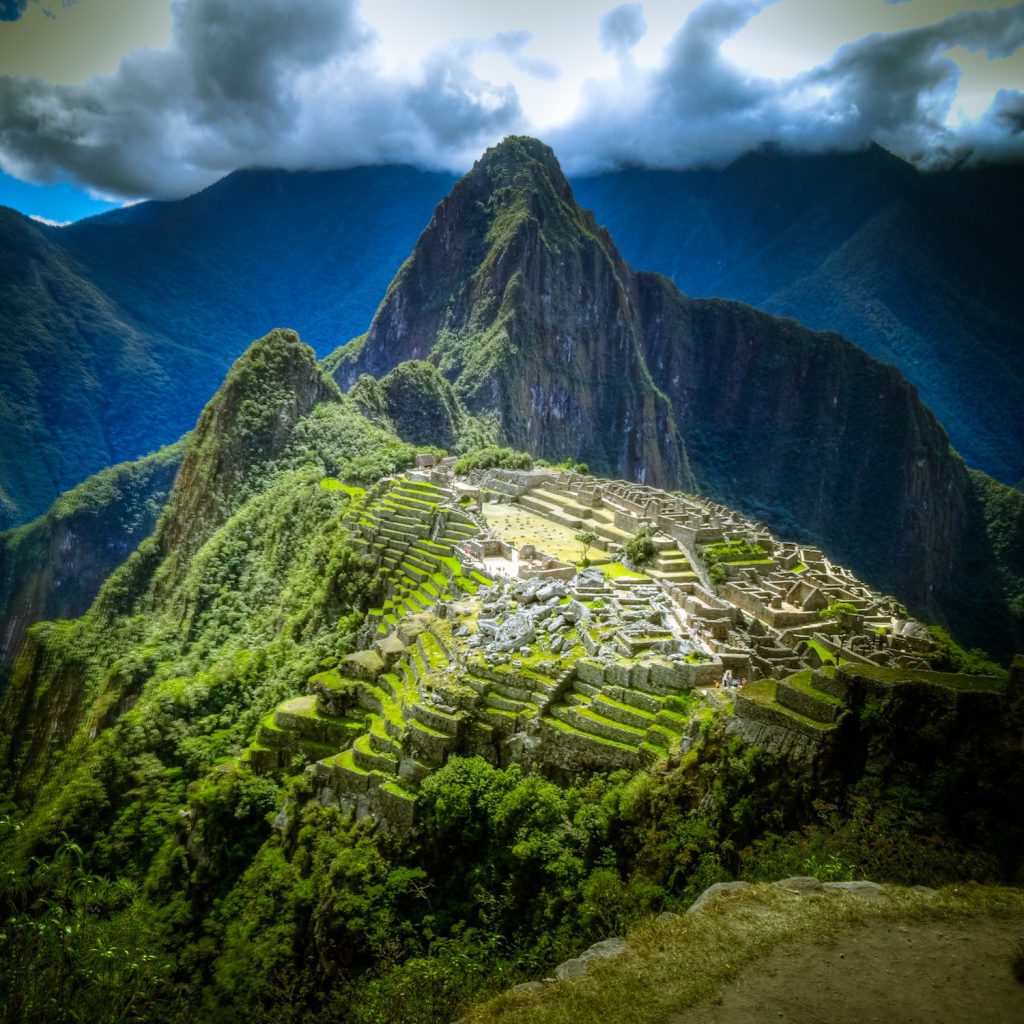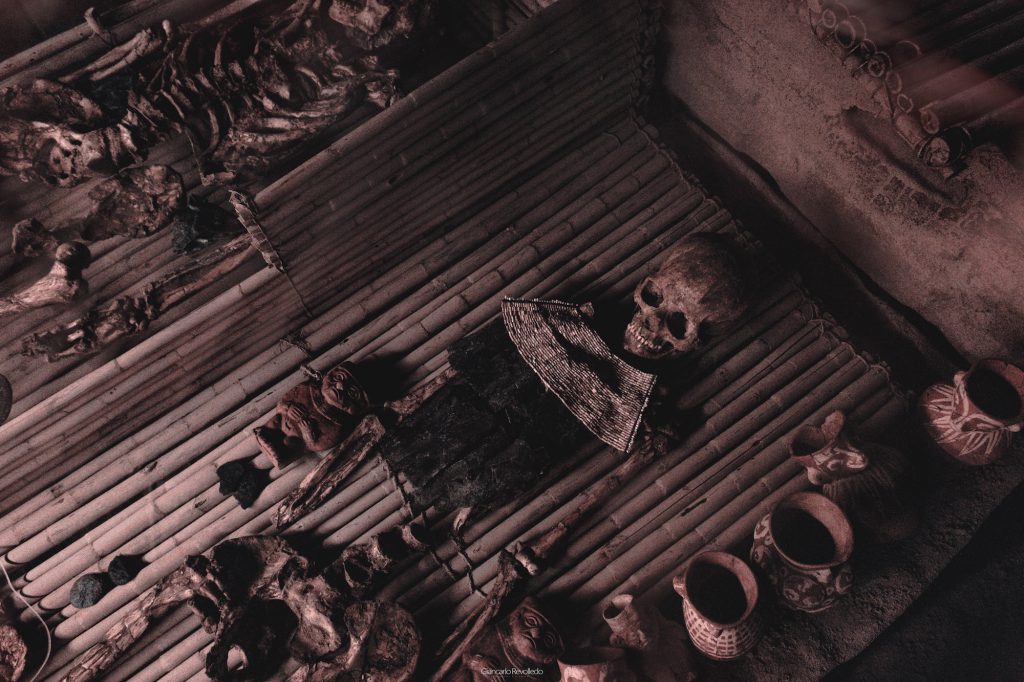Peruvian Empires and the Presentation of Social Identity
by Catherine Fain
An individual’s identity is a complex social construct that receives influence and definition from other individuals, families, and the surrounding political structure. Identity is one of the most difficult aspects to address with the bioarchaeological record, but is extremely important when determining the life and experience of a past individual. This paper addresses and compiles for case studies in the pre-Colombian Andes. Specifically, this paper addresses four sites of known human sacrifice and interment in the Wari, Tiwanaku, Chanka, and Quichua polities. Comparisons of strontium isotope levels, burial arrangement, and skeletal analyses will be made in an effort to determine evidence of distinct “insider” and “outsider” cultural identities. This paper also considers the problematic aspects of studying past identity, and its importance in the modern world.
Introduction
Human sacrifice is widely accounted for in pre-Columbian cultures and highly suggestive for pre-Incan pan-Andean cultural groups, including the Wari (AD 600-1000). This has also been theorized to overlap with the contemporaneous, though culturally distinct Tiwanaku people (AD 300-1100) (Tung, 2010). There is evidence that both the Wari and Tiwanaku had militarism cults and ritual sacrifice incorporating local and non-local peoples. These ritual sacrifices frequently occurred in specifically marked areas, including caves, mountaintops, or “d”-shaped ritual rooms with circular margins (Tung, 2010). The Peruvian Middle Horizon period (AD 600-1000) was dominated by cultural centers of the Tiwanaku and the Wari. This included indoctrination of smaller polities through methods of religious influence, communal feastings, or expansive military campaigns. Typically, the methods each polity followed depended on what each local elite required for sociopolitical compliance (Tung, 2010).
Military prowess and violence are the most well attested avenues for pan-Andean elite control, with groups relying on the promotion of a warrior cult and the taking (and displaying) of trophy heads or dismembered captives. Iconographic evidence points to a male-dominated cult of violence fostered at the highest socio-political level and, to some extent, possibly controlled and regulated by the state itself. The promotion of physically and mentally grueling tasks of dismemberment and captive sacrifice would also entail a changing social identity among the Wari and Tiwanaku, rationalizing and fostering a cult of violence against those Andean individuals deemed to be sacrifice victims.
Prior excavations of the Conchopata Wari site, the Larache Tiwanaku site, and Chanka and Quichua polities using strontium isotope analysis will be analyzed, compiled, and discussed in this paper. These excavations cover temporally successive cultural groups in Andean Peru and focus on signs of human sacrifice or ritual, and systemic violence in burial contexts to determine geophysical outsiders. With emphasis on social science, the possible creation of an outsider identity will be addressed in terms of communal policies against social integration and systematically-targeted violence. This secondary analysis will also explore the current limitations on addressing prehistoric identity, and the expansion required to address one of the critical facets of past human experience.
Methods
Strontium isotope levels accrue in human bone and teeth over a lifetime and are based on underlying bedrock in a geographical area. Weathering and erosion of rock forces strontium into the food web of a local geographic area, and strontium levels maintain the same ratio regardless of trophic level (Bentley, 2006). Long-term strontium isotope change occurs in the bones of the body and can determine geographic movement throughout an individual’s lifetime, while strontium levels in teeth are typically those of childhood location (Bentley, 2006). Tung and Knudson’s (2008) analysis of the Wari Conchopata site, Toress-Rouff et. al.’s (2015) assessment of the Larache cemetery, and Kurin et. al.’s (2016) excavation of the Chanka and Quichua individuals all take advantage of isotopic analysis to quantify local and non-local individuals. The use of cranial modification as a culturally regulated marker will also be considered to assist isotopic evidence in determining non-locals in applicable sites.
Wari-Tiwanaku individuals were also analyzed for bioarchaeological evidence of ritual and structural violence. The prevalence of structural violence depends on every-day habits that reinforce its acceptability (Klaus, 2012). This aspect also lends itself to contemporary ideas of “ritual violence,” which include the use of systematic violence with religious or supernatural connotations (Becker and Frohling, 1998). Ritual violence in the Peruvian Middle Horizon was frequently sponsored by militaristic warrior cults and mixed into state-sponsored ideology. Consistent ritual violence in one area could manifest in precise or targeted acts of violence. Cut-marks related to de-fleshing, singular death blows around the neck, and drill marks for postmortem bone preparation have all be taken into consideration in the included studies.
Evidence and Site Excavation
The Conchopata Wari site lies south of the capital of Huari in southern Peru and served as a major cultural center for the expanding empire. Along with two-hundred standard burials, the excavated area included two ritual buildings. Twenty-four adult trophy heads and nine non-adult cranial remains were excavated by Tung and Knudson, intermingled with burned camelid bones and smashed ceramic urns featuring warrior iconography. Seventeen adults were sexed to reveal a significant male majority. Drilled holes in the cranium were consistently seen in two localities – the apex and occipital skull areas (Tung, 2010). The non-adult skulls, ranging from three to twelve years old (Tung, 2010), had similarly positioned drill holes and mandible cutmarks. Accordingly, de-fleshing would have been accompanied by neck blows and strangulation as the chosen vectors of death. Ritual objects and bronze axes were also found among the Conchopata graves. Strontium isotope analysis revealed two female crania who fell outside of Wari heartland ranges and one young male whose strontium levels differed from long bone analysis and dentin samples (Tung, 2008). Two child crania also fell outside of established ranges. Isotopically distant crania thus made up around 12% of sexed adult crania and 20% of non-adult crania.
The majority of individuals selected for Wari sacrifice were adult males and isotopically came from within the Wari territory. However, Conchopata shows a significant increase in the use of non-local children for ritual sacrifice. These trophy heads have multiple possibilities of collection, including capture during raiding and warfare or Wari locals included in a viable sacrifice class. The presence of warrior iconography, and the illustration of Wari militarists “dangling victims” or “wearing trophies” (Scherer and Verano, 2014) points towards ritualized violence in times of consistent conflict. However, this does not eliminate the potential for local sacrifices classes.
The Tiwanaku polity (AD 300-1100) is viewed as an overlapped contemporary of the Wari cultural and political sphere. Tiwakanu sites included that of the Larache cemetery excavated by Torres-Rouff et. al. (2015) in the Andes Basin. This site in particular would have experienced increased social interaction from the expanding Wari empire, as well as minority cultural groups in the area (Torres-Rouff, Knudson, and Pestle, 2015). Of the 18 tested individuals by the Torres-Rouff research team, five isotopically non-local samples were present and ranged from southern Bolivia to the Wari Heartland as points of origin (Torres-Rouff et. al., 2015). Non-locals again represent a minority of interred burials (approximately 27%) Statistically, there was no significant predictor of cranial modification associated with non-local individual based on strontium isotope analysis (Torres-Rouff et. al., 2015) and no individual had an entirely “foreign” mortuary context. Gold burial goods – the most apparent point of differentiation – presented equally in both local and non-local graves. The five isotopic outliers also failed any correlation of evidence for ritual violence.
High levels of warfare during the Late Intermediate Period in the Andes immediately followed the collapse of the Wari Empire and were worsened by increasing resource scarcity. Two polities managed to coalesce in the Andahuaylas after the decline of both the Wari and Tiwanaku – the Chanka and Quichua. Both polities shared similar material culture motifs (Kurin et. al., 2016) but the Chanka were historically more militaristic and served as instrumental leaders of warfare between the fall of the Wari and eventual rise of the Inca (AD 1000-1200). Ethnohistoric sources indicate evidence of military violence and tension between the Chanka and Quichua (Betanzos, 1557 as cited by Kurin et. al., 2016). Kurin et. al.’s excavation (2016) included two Chanka sites and one Quichua, and the testing of more than 34 individuals ranging in sex and age.
Two isotopic outliers were found at the Chanka cave sites of Cachi and Ranracancha. One was among fourteen isotopically analyzed individuals at Cachi and one among ten analyzed individuals at Ranracancha (Kurin et. al., 2016). These compose a significant minority of 7% and 10%, respectively. Both individuals were females who suffered repeat violence in the form of healed and penetrating cranial wounds, as well as nutritional deficiencies of porotic hyperostosis and cribra orbitalia (Kurin et.al., 2016). These are systematic markers of poor diet and often occur in individuals in poverty, poor resource access, or those facing reoccurring disease (Klaus and Tam, 2009). Cranial modification was not present in a majority of local individuals at Cachi and Ranracancha. There are also few documents illustrating cranial modification’s historic presence among the Chanka. It was thus assumed to not have been a core cultural practice.
Using strontium markers to source locality, two of 20 tested males (20%) were deemed non-locals at the Quichua site of Pucullu. Both were middle-aged (30-50 years of age) and had slight cranial modification (Kurin et. al., 2016). One male had two well-healed cranial injuries. Cranial modification was included in these samples because of its correlation between those who were isotopic outliers. This is applicable for both the Chanka and Quichua excavations. Cranial modification in the Andean Middle Horizon was also frequently used to physically denote social status or cultural identity (Kurin et. al, 2016).
Discussion
State-mandated ideological expansion is one possible influence on the determination of a sacrificial outsider, as indicated with Tung and Knudson’s stratigraphic excavations. Smashed urns found within the Wari Conchopata site tend to be significantly larger than household level production urns and exhibit a standardized warrior motif (Isbell and Cook, 2002). Regulated and standardized vessel creation and distribution would link this ritual militarism with the ruling ideological class. The consistency in the placement of drilled cranial holes (Tung, 2010) additionally points to standardization among Wari sacrifice, and possibly larger political oversight to the process itself. Participation in the Wari cult is alluded to as an elite practice again with the burial of bronze ceremonial weaponry among local Wari graves. An entirely separate warrior class may have shared in this elite status (Scherer and Verano, 2014), with surrounding urns venerating and celebrating this every-day violence. Wari class identity changes within an existing structure could also explain the presence of local individuals in sacrifice. The actions of the warrior class are ritualized, thus local sacrifice victims rationalize their actions as honorable.
A state agency can create identity in times of conflict, relying on incorporating violence into every-day life, and militarizing individual actions outside of the battlefield. Overt symbolism, images, and language choice serve to reinforce this (Cameron, 2012), and these innocuous actions pave the way for increases in violence from many individuals, not just those involved in military campaigns (Janusek, 2008). Contradictions are rampant in such ideological shifts, including psychological dissonance that must be corrected to ensure ritual participation (Hinton, 1996). Moral restructuring is often necessary to promote military ritualism, even to the point of killing those who are technically “local” or even identify as “Wari”. This restructuring, in the case of the Wari, may have taken the form of itemization and substituting singular individuals for groups in their entirety. One popular form of this would include the sacrificial victim serving as a faithful representative for the entire Wari culture.
The complex creation of identity and its malleability at Conchopata is most evident in one outlier male with conflicting dentin and long bone strontium isotope measures. Enamel measurements fell within Wari strontium ranges, but long bone isotope measurements placed him as significantly outside acceptable limits (Tung, 2010). This individual is assumed to have spent his adult life elsewhere after experiencing a Wari childhood. If this man was taken as a captive, his previous Wari identity and possible ethnicity might have not guaranteed his social incorporation as an adult. These measurements may also represent the opposite- that a former Wari individual was reincorporated at the highest level of honor, serving as a sacrifice. The development of the Wari outsider identity does appear to be advantageous in times of war. Despite their collapse and the temporary rise of the Chanka and Quichua polities, Wari militarism is most likely a direct predecessor of the eventual Inka Empire (Tung, 2008) – who escalated these policies against “outsiders” to develop one of the largest and most violent empires in pre-contact South America. While this study points directly to the creation of an overt warrior identity rooted in violent acts on others, the exact definition of a Wari outsider identity is less concrete.
The Tiwanaku Larache site has been included because of its overlapping geographical and social status as the neighboring Wari. Historically, the Larache would have been dealing with similar levels of violent consolidation and interacted with the same non-locals that the Wari did. Larache graves are theorized to represent integrated non-locals into local culture and mortuary practices (Torres-Rouff et. al., 2015), given that they are not in marginalized gravesites, grave goods are not correlated with non-local strontium markers. The Tiwanaku concept of “ayllu” (Janusek, 2008) may relate to an agency that did not favor an overt sacrificial cult, though human sacrifice is still accounted for in the Tiwanaku culture (Tung, 2010). Ayllu translates roughly to “kinship” or “community” and was sponsored through empire-wide cultural events. This may have provided a basis for social coherence among the multiethnic Tiwanaku polity. Ayllu embodied shared cultural practices, ancestry, and a common identity. This system also meant coherence within an innately hierarchical system (Janusek, 2008). State leaders emphasized strategies of integration including craft production regimes, ideologies and reciprocal storage jar deposits (Janusek, 2008). The gold items found at the Larache site may have serve as evidence for such reciprocation.
Both the Chanka and Quichua illustrate the influence of conflict in determining social outsiders. The Chanka females substantially suffered systematic violence and long-term marginalization. These two women were marked by cranial modification and targeted at a substantially higher frequency than those without modification (Kurin et. al., 2016). Their age (between 18 and 25) also suggests the possibility of “forced displacement” as raid victims (Cameron, 2016). These females, if taken during displays of military power, failed to be culturally integrated and were systematically faced with violence. The fate of these women illustrates the militarization of society bleeding into a system of structural violence. Abuse and recidivism were possibly rationalized because these women were not considered culturally Chanka (Kurin et. al., 2016). Their non-local origin could have been enhanced by the physical markers of significantly modified crania. The policies behind forming an outsider identity are less clear among the Chanka than among the state mandates of the Wari, but the Chanka individuals serve as examples of the higher risks to non-locals in times of conflict.
The Quichua males point to the possible malleability of outsider identity in favor of military necessity. Both non-locals were older males, showed signs of continuous participation in warfare, and had multiple healed injuries. Higher male participation in violence is common during expansive conflict situations, and these men may have served as allied fighters to the local Quichua (Kurin et. al., 2016). These non-locals may have been accepted and incorporated to an extent because they were considered allies, or were culturally similar (Kurin et. al., 2016). A more comprehensive study on the Quichua military alliances of the post-Wari Andean world, and cross-referencing the strontium isotope ranges within each polity, could be conducted to better place these males and illuminate the idea of allied integration.
Conclusions and Contemporary Connections
The pre-Columbian Andes faced extensive warfare and empirical expansion well before the rise of the Inca, and show evidence of well-established states and cultures. The Wari, particularly, show signs of warrior cult iconography on a state sponsored level, though site-specific studies like Tung 2010 and Isbell and Cook 2002 are not readily applicable for Tiwanaku or Quichua areas. The Tiwanaku site, Chanka, and Quichua excavations do show proof of isotopically identified non-locals and possible relationships to military alliances, communal identity, and structural violence. However, in all sites non-local individuals represent a minority of all excavated individuals and do not equate to more than 30% of all bodily remains in any single site, either in sacrificial or simple mortuary contexts. Additional excavations within pre-Columbian territories would provide a statistical standard for the total number of non-locals present, but this has yet to be accomplished.
The effect of concise and discrete identity factors are also still unclear in most of the aforementioned studies. The grasp on the insider and outsider identity dichotomy would benefit from the expanded application of art history, burial context, and historiographic records alongside continued isotopic information. These applications are documented for the Wari polity. The bioarchaeology of ancient identity will continue to grow as methods and cross-topic academic interaction increase. Interdisciplinary research with sociology will be particularly helpful in determining how individuals viewed and expressed themselves. The plurality or even contradicting definitions of identity will benefit from highly contextualized individual community studies. This is especially important for minority groups, including the biological outsiders in these studies.
Discussion of the outsider identity and its subsequent formation, is a critical topic when confronting multiethnic communities and expanding social connections in globalized settings. Cultural differences continue to marginalize groups and lead to structural disadvantages. The accumulation of structural violence over multiple generations can result in the same systematic disadvantage in contemporary populations. This is especially true of minority people, many of whom remain unaccounted for in bioarchaeological research. The perception of unbridged cultural distance may heighten the disadvantages experienced by displaced persons in times of conflict (Detollenaere, 2017), as well as influence how migrants identify themselves in “foreign” communities. Analyzing the changing creation of social identity throughout the Pre-Incan Andes proves the complicated, multi-source basis for who is determined an outsider, an insider, and a cultural minority.
References
Becker, T. and Frohling, U. (1998). Definitions of ‘ritual violence’. Lüneburg. Retrieved from http://download.beckertho.de/open/Definition_of_Ritual_Violence.pdf
Bentley, R.A. (2006). Strontium isotopes from the earth to the archaeological skeleton: a review. Journal of Archaeological Method and Theory, 13, 136-187.
Cameron, C. (2016). Captives: How Stolen People Changed the World. Lincoln: University of Nebraska Press.
Detollenaere, J., Baert, S., and Willems, S. (2017). Association between cultural distance and migrant self-rated health. European Journal of Health Economics, 19, 257-266.
Hinton, A.L. (1996). Agents of death: explaining the Cambodian Genocide in terms of psychosocial dissonance. American Anthropologist, 98, 818-831.
Isbell, W. and Cook, A. (2002). A new perspective on Conchopata and the Andean Middle Horizon. Andean Archaeology II: Art, Landscape, and Society, edited by Helaine Silverman and William H. Isbell, 249-305.
Janusek, J. (2008). Collapse as cultural revolution: power and identity in the Tiwanaku to Pacajes transition. Foundations of Power in the Prehispanic Andes, 14, 175-209.
Klaus, H. and Tam, M. (2009). Contact in the Andes: bioarchaeology of systemic stress in colonial Morrope, Peru. American Journal of Physical Anthropology, 138, 356-368.
Kurin, D. S., Lofaro, E. M., Choque, D. E., and Krigbaum, J. (2016). A bioarchaeological and biogeochemical study of warfare and mobility in Andahuaylas, Peru (ca. AD 1160-1260). International Journal of Osteoarchaeology, 26, 93-103.
Klaus, H. (2012). The bioarchaeology of structural violence: a theoretical model and a case study. In: Martin, D., Harrod, R., and Perez, V. (2012). The Bioarchaeology of Violence. Gainesville: University of Florida Press, 29-62.
Scherer, A. and Verano, J. (2014). Embattled Bodies, Embattled Places: War in Pre-Columbian Mesoamerica and the Andes. Washington, D.C.: Dumbarton Oaks Research Library and Collection.
Torres-Rouff, C., Knudson, K.J., and Pestle, W.J. (2015). Tiwanaku influence and social inequality: a bioarchaeological, biogeochemical, and contextual analysis of the Larache cemetery, San Pedro de Atacama, Northern Chile. American Journal of Physical Anthropology, 158, 592-606.
Tung, T. and Knudson, K. (2008). Social identities and geographical origins of Wari trophy heads from Conchopata, Peru. Current Anthropology, 49, 915-925.
Tung, T. and Knudson, K. (2010). Childhood lost: abductions, sacrifice, and trophy heads of children in the Wari empire in the ancient Andes. Latin American Antiquity, 21, 44-66.
Acknowledgments: I would like to thank Dr. Laurie Reitsema and Samm Holder for their guidance and instruction in my research. I could not have done this without your immeasurable help. I would also like to thank my family—Randy, Jean, and Jessica—for their constant support in my pursuits.
Citation style: AJPA
. . . . . . . . . . Return to the Table of Contents.



